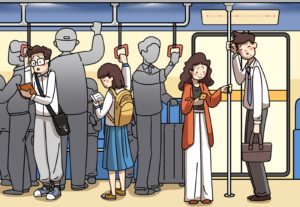Jan 26, 2021|
JD Big Data: The Who, What and Where of Chinese Readers
by Vivian Yang
What books are Chinese people reading, and when and where do they read? To find answers to these questions, JD Big Data Research Institute studied the vast data of JD Books, JD’s book sales department, and revealed a number of interesting findings.
The report launched on Jan. 19 in collaboration with Xinhua News Agency, China’s largest news agency in the form of an online trivia game where readers can test their knowledge and receive more information about reading habits.
“We looked at consumption data for the past ten years on JD Books,” said Fei Lu, senior researcher of the institute. “We hope our findings will help people better understand their own reading behaviors and guide them to more books that are suitable and helpful for them.”
Below are some key findings of people in different reading scenarios:
On the subway
Middle school students and young professionals turn out to be earnest book-reading subway commuters, according to JD’s big data.
Foreign language learning books are one of young people’s favorites. They account for more than 31% of this book category.
Office workers read a lot of success books, with male users buying 1.5 times more than female users. Meanwhile, office workers also consume more psychology-related books (61%) than other age groups possibly to strike a balance in life.

On the Plane
Business people waste no time, often reading management books on the plane. In addition, JD’s data shows that people between 26 to 35 years-old make up more than half of the management books consumers on JD.com.
Taking flight also gives time for many mothers to read books on parenting. Women bought more than 76% of books in this category.

In the Library
While kids are thirsty for all kinds of knowledge, with sales of children books ranking second in the overall list of book sales on JD.com, adults are busy taking examinations. Data shows that people between 26 to 35 years-old bought more than 50% of examination-related books for adults.
The real pensive thinkers, however, appear to be those aged above 56, as they are the group of consumers who bought more philosophy books than any other age groups.

In the Coffee Shop
In terms of reading hobbies, the book consumption data generally reflected certain gender stereotypes: male users bought more books on success, management, IT and internet, while female users prefer more books on youth literature.
Among the readers of economics books, there are twice as many men as women. When it comes to painting books, both genders are almost the same.

In Bed
JD’s big data shows that the peak hour for e-book reading is 9-10 p.m. Books on investment, management, literature and leisure are the most popular during this period.
Besides school related books, teenagers also like to read novels before going to sleep. For smaller kids, reading for them is always a good way to put them to bed. Data shows that more than 20% of users between 26 to 35 years-old have ordered children books online.

Over 10 years of its development since 2010, JD Books has grown to be China’s leading e-commerce platform of selling books, with a comprehensive reading offerings of books, e-books, reading software and hardware, knowledge services and more.






 Ecommerce Report: Chinese Consumers Increasingly Motivated by Health-Consciousness
Ecommerce Report: Chinese Consumers Increasingly Motivated by Health-Consciousness



